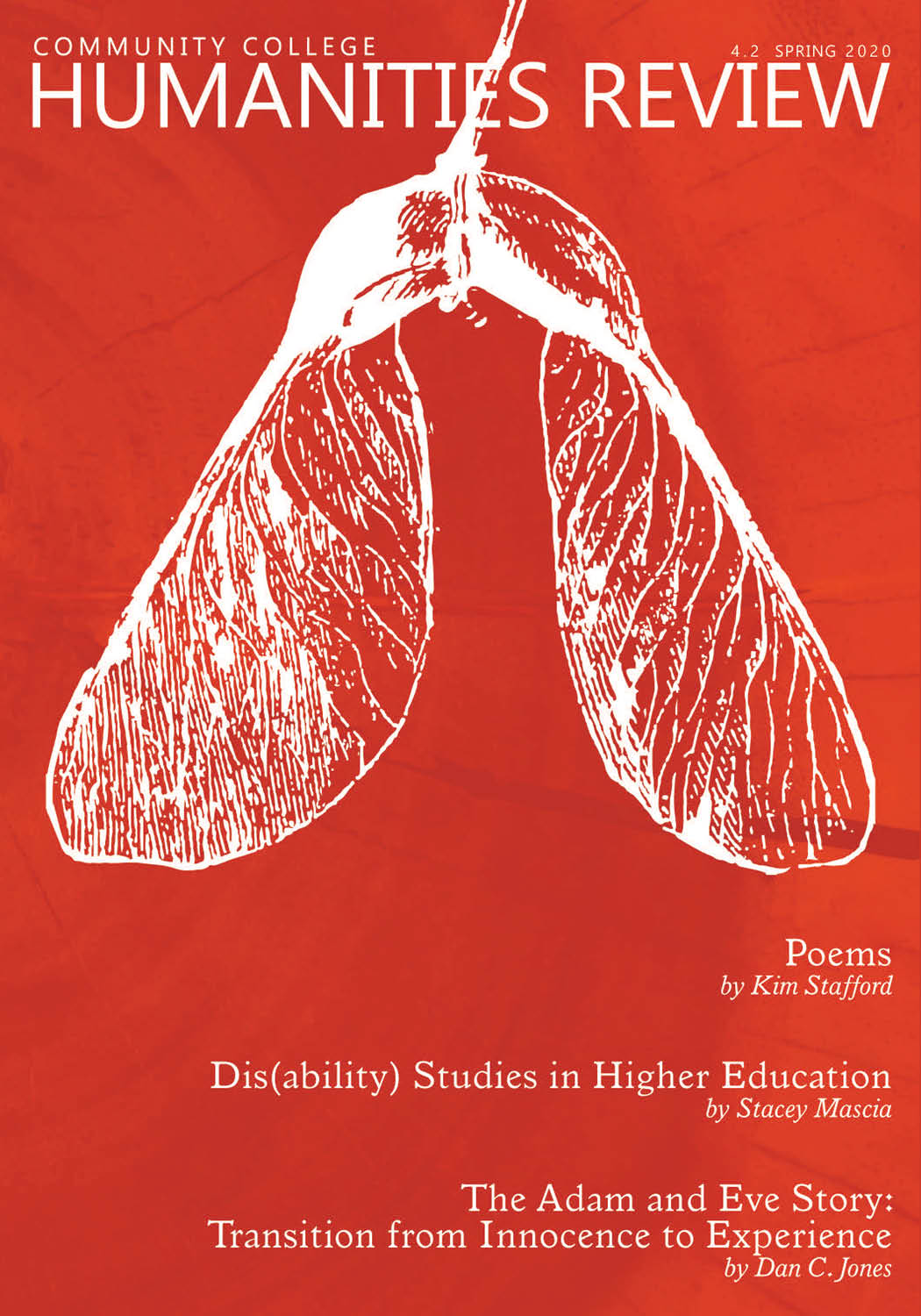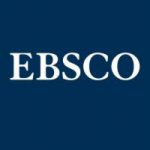Want a peek at the CCHR? See the teasers below!
The Community College Humanities Review Journal
The Community College Humanities Review (CCHR) journal, published biannually by the Community College Humanities Association (CCHA), has gone through an extensive redesign and reevaluation of editorial content. Along with the publication’s historical penchant for outstanding peer-reviewed scholarship, CCHR is now publishing essays on pedagogy, faculty profiles, book reviews, columns, fiction, poetry, and first-person reflections on life as a community college humanities professor. Further information on our Submission Guidelines below.
For “conventional” humanities disciplines such as history, philosophy, literary studies, composition, comparative religion, and ethics, CCHR provides the latest in research and pedagogy. The publication also leads the charge in expanding the definition of what studying the humanities may come to mean in the future. CCHR intends to explore, from a humanities perspective and with the intention of building bridges with other disciplines, such subjects as climate change, income inequality, environmental racism, terrorism, sustainability, media literacy, and biotechnology.
With expanded editorial content, CCHR is better able to serve CCHA’s members, as well as reach the larger higher education humanities community. CCHR is the go-to for the past, present, and future of humanities education in community colleges. Since the re-launch, CCHR has assumed its position as the signature publication of the Community College Humanities Association and be a welcome and important contribution for any individual and/or institution where the humanities are taught or explored.
Edited by Sydney Elliott, The Review is available via Amazon by clicking the link below. Additionally, more information about our Submission Guidelines can be found HERE.


.
Get the Community College Humanities Review Journal (CCHR) delivered to your library; it’s easy to do! Masyn Phoenix, Library Director at Tillamook Bay Community College, is here to tell you how just how easy it is. “Subscribing to the Community College Humanities Review is easy. Just ask your friendly neighborhood librarian to subscribe for you through EBSCONET. ISSN# 0748-0741.” Thanks, Masyn!
Want a peek at the CCHR? See the teasers below!
Contact information
Sydney Elliott, Editor
sydneyelliott@tillamookbaycc.edu
Submission guidelines
Community College
HUMANITIES REVIEW
The Community College Humanities Review is published by the Community College Humanities Association (CCHA). The goal of the journal is to highlight the scholarly and creative work of community college humanities faculty. The editor encourages progressive approaches to writing about the humanities in community colleges, welcoming but also questioning conventional subject matter while inviting community college humanities faculty to take a fresh look at, for example, culture, the environment, the politics of food, climate change, genetic engineering, whatever new challenges a humanities mindset may help, in an integrated approach with other disciplines, to solve. The Community College Humanities Review strives to be the go to publication for community college humanities scholarship and creativity.
Submission Guidelines
Writing
Please query CCHR’s editor, Sydney Elliott, at sydneyelliott@tillamookbaycc.edu. Submissions will only be accepted through email in MS Word, 12 point, Times New Roman font, double spaced, left justified, with one-inch margins and page numbers in the upper right corner. There should be no headers or footers. CCHR rarely accepts any work over 7,000 words. Most texts should fall between the 2,000 – 7,000 word range. For additional format requirements concerning research submissions, see below.
Research
CCHR accepts well-researched articles by community college humanities faculty. Along with the above writing guidelines, scholar writers should follow MLA format and use endnotes (not footnotes) when necessary. Please restrict the number of explanatory or digressive endnotes that are excessively long. Limit the total number of endnotes to bibliographic references. Use superscript Arabic numbers in text, avoid the use of other symbols like asterisks. Embed tables, figures, charts, graphs into the narrative as close to the in-text reference as possible. Limit the number of appendixes.
Creative Nonfiction
Essays – CCHR accepts well-written personal experience and critical essays as well as long-form, literary journalism written by community college humanities faculty. Essays on novel pedagogy and teaching experiences are encouraged.
Profiles – Creative profiles in the long-form tradition should focus on community college humanities faculty or those who are in some significant way associated with community colleges.
Interviews
Interviews, in Q&A format, will be accepted as long as the interview subject has particular relevance to the teaching of humanities in community colleges. Please query Editor Sydney Elliott.
Fiction
CCHR accepts well written short stories of any genre, generally 1,000 to 7,500 words. Higher consideration is given to quality writing and the ability to tell a good story. Both character- or plot-driven stories welcome for review. CCHR publishes one short story per issue, more depending on the discretion of the editor. Send your best work. No previously published material. Yes on simultaneous submissions.
Poetry
Poets may submit up to five poems in any form. Publication design guidelines prohibit the guarantee of poet-designated line breaks. We’ll do our best to accommodate. Thoughtful, imaginative poems should resonate. Send your very best work. No previously published material. Simultaneous submissions are ok.
Photography
Subject to the editor’s discretion, The Community College Humanities Review accepts photography by community college humanities faculty. Photos may need to be conducive to the thematic content of a particular issue.
In This Issue:
Sneak Peek
Stacey Mascia:
“Dis(ability) Studies in Higher Education: Student-Centered, Collaborative Model”
The teacher cannot think for her students,nor can she impose her thought on them. Authentic thinking . . . that is concerned about reality, does not take place in ivory tower isolation, but only in communication. —Freire, Pedagogy of the Oppressed
Film, Sideshow, and Circus
Community colleges offer an affordable education in an accessible environment with great support systems in place and educators who are engaged in students’ academic success. Given the latitude we receive as junior college educators in terms of the “publish or perish” expectation in four-year colleges and universities, we have more time to meet with students individually, to invest time in economically challenged, rural communities, and to nurture students in academics and life’s challenges. While there is scholarship in cultural readings of circus and sideshow venues as well as film and disability studies, my students and I focus specifically on films that exhibit bodies of difference. Subsequently, the gaze framework experienced in specialized Humanities courses reflect the changing perspectives in academia by which we understand the beauty of bodies of difference in a world that has focused its gaze upon binaries like ab/normal or dis/symmetry in normative terms. The educative gaze can be experienced through film and literature using cultural critiques aside scholarly research; educators can then include students in the gaze process as we discuss documentaries and classic films such as Freaks (1932) among others discussed in this study. After viewing films depicting bodies of difference that defy normative readings, the students discuss a variety of social issues such as: censorship (as Freaks was banned in Great Britain for over thirty years); cultural egocentrism; progression of disability studies; binaries like of beauty versus ugliness; and other ethical consideration.
This educative gaze takes place when the instructor and students interact collaboratively, rather than in the traditional lecturer/listener model most of us experienced as students. For example, some insightful feedback from my students inspired me to collaborate on this paper with them. In HUM 202: Film II Aesthetics and Culture, Special Topic of Representations of Disability in Society, one of my students noted that:
Disability is not the same as inability and shouldn’t be seen as so by society. People like Mat Fraser make beautiful art and contribute to society despite the condi- tions they are put in. To move forward on helping fight the stigma on disability, further education on disabilities could be pursued by schools. (Willett)
The educative gaze also takes place when the instructor and students interact and challenge one another. An exploration of films that feature sideshow and circus performance arts, as well as developmental, physical, and psychological disabilities is a wonderful paradigm for discourse, research, and instruction. In this course, we view other films such as The Elephant Man (1980) and the more recent Wonder (2017). Initially, my students were uneasy about the prospect of studying disability through sideshow, circus, or film studies, but ultimately, they were moved intellectually and emotionally by the material, as one student shared with me (Bombard). She offers that:
[w]hen disabilities are studied it is notice- able that illness[es] or syndrome[s] are not what disables them. It is the way people treat them that disable them. When looking at what a human is through the study of aesthetic value, social identity and disability studies[,] it broadens the picture of . . . a human . . . (LeClair)
This is precisely what we do in the humanities: we explore the human condition, its constraints, and its possibilities in all facets of our existence. We consider critical analysis of performance arts and disability studies.
Want to continue reading? Please consider purchasing a print copy or becoming a member.
Sneak Peek
Dan C. Jones:
“The Adam and Eve Story: Transition from Innocence to Experience”
After my retirement from one community college, following long-term service as an English faculty member and instructional administrator, I found myself returning to the classroom at another community college for several years. In this new setting, I had an opportunity to teach regularly a full-year survey course in world literature that I had never taught before, having previously taught survey courses only in British and American literature. It was the teaching of this course, which included selections from the literature of The Hebrew Bible, along with related works written before and afterwards, that led me to a more comprehensive understanding of the Adam and Eve story. The key to this new understanding came from the ability to focus on this biblical story not only in terms of religious doctrine, but also as literature integrally related to other literature of the ancient world and afterwards.
The Adam and Eve story (in Genesis 2–3 in the Hebrew and Christian Bibles) has always been of great interest to me as a Protestant, and throughout my life my understanding of this story has continued to grow and develop. While I grew up with and have come to understand more fully the Protestant and Roman Catholic doctrines derived mainly from Augustine of Hippo, I also have become open to different ways to view the Adam and Eve story. Ultimately, I came to understand from my own academic training that literary interpretations of ancient writings can have their own integrity, independent of theological interpretations developed for different reasons. More specifically, I came to understand that the best literary interpretations most often take into full account the context of the world in which the author is writing, while theological interpretations may consider other issues to be more important.
For example, Augustine, especially in the last thirty years of his life, was not concerned with literary types of analysis and interpretation of the Adam and Eve story, and he was never concerned with such matters as historical/cultural context and writer-audience relationship. Rather, Augustine, in multiple works, including The City of God in Books 13 and 14, was concerned primarily with his developing theory of the role of providence in Christian history and its relationship to the theology that he was developing, including the concept of original sin, which later became firmly established in Roman Catholic and Protestant doctrine. Stephen Greenblatt, in The Rise and Fall of Adam and Eve, observes that Augustine, in the last half of his career, determined that his earlier attempts at allegorical interpretation of the Adam and Eve story were “a mistake” (111) and that he then shifted his focus to a view of the narrative as an account of a literal historical event to make more credible his view of the biblical account as the essential beginning portion of his grand vision of “the divine plan” (97). His theology became grounded in what he perceived to be a historical pattern rather than grounded in literary types of interpretation. In addition, there was no interest in the issue of authorial intention or the ways in which the events themselves, or the values they suggest, may have been perceived by the story’s audience of ancient Hebrews.
Want to continue reading? Please consider purchasing a print copy or becoming a member.
Sneak Peek
Kelli Nakamura & Michelle Chin:
“Celebrating Indigenous Knowledge & Empowering Communities through ‘Aina-Based Learning”
Place-based or ‘āina-based learning enhances instruction, improves student engagement, and teaches students to learn about and be a part of their community by encouraging students “to take care of the world by understanding where they live and taking action in their own backyards and communities” (Center for Place-Based Learning). ‘Āina-based learning connects students to their local culture or landscape and asks students to not be passive members of the community, but agents of change. This approach provides a purpose and a passion for students, creating motivation, encouraging participation, promoting self-efficacy, and teaching real-world application. This study focuses on the importance of developing ‘āina or place-based learning at two-year institutions that (re)connects classrooms and students to their communities to increase student engagement, learning, and achievement. As community colleges traditionally have a more diverse student population than four-year institutions, it is critical that community colleges understand the needs of the communities that they serve and their histories. This approach can be valuable for students enrolled in 100-level or developmental education classes as ‘āina-based learning encourages student engagement, which is a critical factor in student retention. Through the incorporation of indigenous voices, knowledge, and experiences, students are empowered to celebrate their own identities and participate as agents of positive change in their communities.
The Importance of ‘Āina-Based Learning:
(Re) connecting Students to their Communities
Although some may regard place-based education as a new teaching approach, it has been around for many years in American education. In the early twentieth century, philosopher and educator John Dewey noted that in the psychology of elementary education, “the aim, then, is not for the child to go to school as a place apart, but rather in the school so to recapitulate typical phases of his experience outside of school, as to enlarge, enrich, and gradually formulate it” (99). Dewey clearly understood the importance of students being a part of their community, providing meaningful contextual experiences to classroom concepts. By utilizing the communities that students live in to help them understand concepts, place-based education creates learning that is personally relevant and meaningful, fostering “essential connections with their history, place, culture, and future” (Harada 8).
Additionally, for many indigenous communities, notions of place-based learning have been an integral part of their very culture. In Hawai‘i, many educators such as Brandon C. Ledward of the ‘Āina-Based Education Department at Kamehameha Schools, recognized the importance of an ‘āi- na-based education (Kana‘iaupuni and Malone 281). According to Ledward, “‘Āina-based learning is teaching and learning through ‘āina so our people, communities, and lands thrive. ‘Āina refers to the land, sea, and air—all that feeds and sustains us” (35). Ledward explained that many Hawaiians have a familial connection to the land and believe that they have a kuleana (responsibility) to each other and to the planet:
The ‘āina is as much a theater for learning as it is a repository of life. ‘Āina can be a teacher, a classroom, and a living laboratory for education in next-century skills, sustainability, and self-determination. It provides a rich context for developing critical thinking and problem solving, communication and team-building, and political consciousness. (35)
While scholars have recognized the importance of ‘āina-based education in K-12 education, little research has been done on its role in post-secondary education.
Want to continue reading? Please consider purchasing a print copy or becoming a member.
